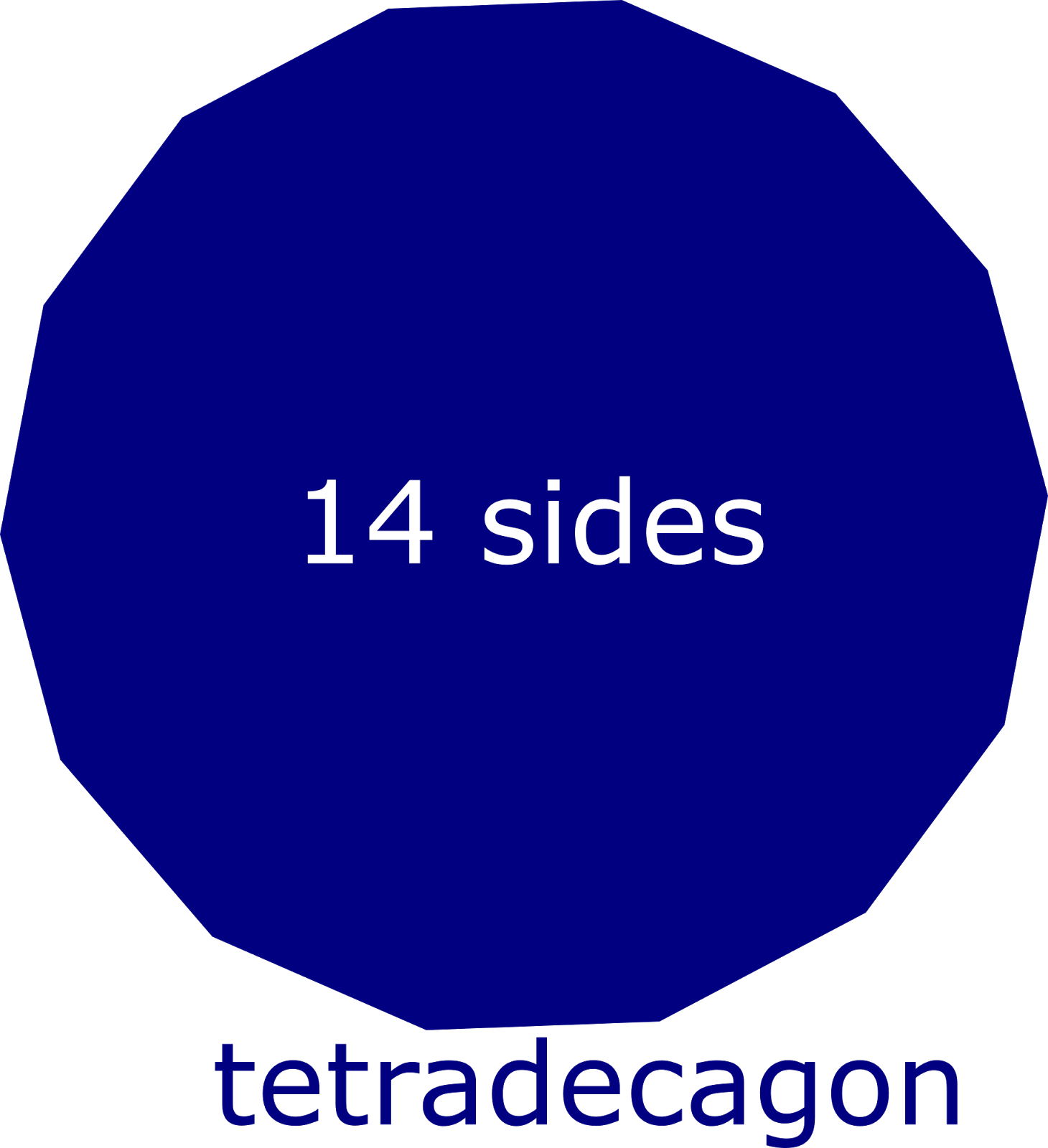A Shape With 14 Sides: Understanding The Tetradecagon
A shape with 14 sides is known as a tetradecagon. This fascinating polygon is not just a simple geometric figure; it holds significance in various fields such as mathematics, architecture, and art. In this article, we will delve deep into the characteristics of the tetradecagon, its properties, uses, and much more. Whether you are a student, a teacher, or simply an enthusiast of geometry, this comprehensive guide aims to enhance your understanding of this intriguing shape.
The study of polygons is a vital part of geometry. Polygons are two-dimensional shapes that are made up of straight lines and are closed figures. The tetradecagon, with its 14 sides, is one of the many polygons that exist. Understanding the tetradecagon can provide insights into more complex geometric concepts and applications.
As we explore the world of the tetradecagon, we will cover its definition, properties, formulas, and real-world applications. We will also look at how it compares with other polygons and its significance in various mathematical problems. So, let’s embark on this geometric journey to uncover the beauty of a shape with 14 sides.
Table of Contents
- Definition of a Tetradecagon
- Properties of a Tetradecagon
- Formulas Related to Tetradecagons
- Types of Tetradecagons
- Constructing a Tetradecagon
- Real-world Applications of Tetradecagons
- Comparing Tetradecagons with Other Polygons
- Conclusion
Definition of a Tetradecagon
A tetradecagon is defined as a polygon that has 14 sides and 14 vertices. In the realm of geometry, it is categorized as a convex polygon if all its interior angles are less than 180 degrees. Conversely, if one or more of its interior angles is greater than 180 degrees, it is considered a concave tetradecagon.
Characteristics of a Tetradecagon
- Number of Sides: 14
- Sum of Interior Angles: 2160 degrees
- Each Interior Angle (Regular Tetradecagon): 154.2857 degrees
- Exterior Angle: 25.7143 degrees
Properties of a Tetradecagon
The properties of a tetradecagon can be intriguing for both mathematicians and geometry enthusiasts. Here are some key properties:
- Convex vs. Concave: As mentioned, a tetradecagon can be either convex or concave, affecting its internal structure.
- Regular vs. Irregular: A regular tetradecagon has all sides and angles equal, while an irregular tetradecagon does not.
- Symmetry: A regular tetradecagon exhibits rotational symmetry and has 14 lines of symmetry.
Formulas Related to Tetradecagons
Understanding the formulas associated with tetradecagons can aid in calculations and applications. Here are some essential formulas:
- Sum of Interior Angles: (n - 2) × 180, where n is the number of sides. For a tetradecagon, it’s (14 - 2) × 180 = 2160 degrees.
- Measure of Each Interior Angle (Regular): [(n - 2) × 180] / n = 154.2857 degrees.
- Exterior Angle: 360 / n = 25.7143 degrees.
Types of Tetradecagons
There are two main types of tetradecagons: regular and irregular. Understanding these distinctions is crucial for applications in various fields.
Regular Tetradecagon
A regular tetradecagon has all sides and angles equal. This symmetry makes it appealing in design and architecture.
Irregular Tetradecagon
Conversely, an irregular tetradecagon has sides and angles of different lengths and measures. This shape is often found in natural forms and is studied in various scientific fields.
Constructing a Tetradecagon
Constructing a tetradecagon can be achieved through various methods. A common approach is using a compass and straightedge, following these steps:
- Draw a circle of a desired radius.
- Mark a point on the circumference to start.
- Using a protractor, divide the circle into 14 equal sections, marking each vertex.
- Connect the points to form the tetradecagon.
Real-world Applications of Tetradecagons
Tetradecagons can be observed in various real-life applications:
- Architecture: Tetradecagonal shapes may be found in specific architectural designs and structures.
- Art: Artists often use geometric shapes, including tetradecagons, in their works.
- Mathematics: Tetradecagons are studied in advanced geometry and can be used in mathematical proofs.
Comparing Tetradecagons with Other Polygons
When we compare tetradecagons with other polygons, several factors come into play:
- Simplicity: Tetradecagons are more complex than triangles and quadrilaterals but simpler than polygons with a higher number of sides.
- Symmetry: Regular tetradecagons have more lines of symmetry than polygons with fewer sides.
- Applications: While many polygons are used in everyday life, the tetradecagon has unique applications in art and architecture.
Conclusion
In conclusion, a shape with 14 sides, the tetradecagon, is a fascinating polygon that holds significant mathematical and real-world relevance. From understanding its properties and formulas to exploring its applications, we have uncovered the beauty of this geometric figure. If you have any thoughts or experiences related to tetradecagons, feel free to leave a comment below!
For more insightful articles about geometry and mathematics, be sure to explore our other content. Your journey into the world of shapes and figures doesn't have to end here!
Is Trent Muslim? Exploring The Beliefs Of The Notable Figure
John Waite Married: A Look Into The Life And Relationships Of The Rock Icon
Exploring The Love Life Of James Charles: Who Is His Boyfriend?


